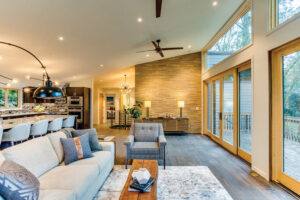Illustration by Carly Larsson
A few years ago, my mother and I were going through the junk that had accumulated in her barn when she handed me a dusty, cobweb-covered floor lamp with a fluted shaft and a green marble base, a trio of candle sockets missing their bulbs, and a rodent-chewed cord.
“This would look great in your house,” she said.
While I appreciated the ornate scrollwork, I also imagined this lamp sparking a fire and burning my house to the ground. But who says no to her mother offering a gift? Not me. So the lamp sat in the corner of my living room for a few weeks, ignored, until I finally relented and polished it with a soft cloth. Maybe I could resell it to someone more capable of restoring it.
Antiques sing to me, and nothing sings more beautifully than antique lights. Maybe it’s the years of suffering grimy buildup, or perhaps it’s that they bear witness to a time when form, even in basic appliances, was as important as function. That floor lamp began singing in a quiet, persistent way. It reminded me of my grandmother—the 1920s teenager with an infectious smile, wearing a short, beaded dress and heels. The more I thought about her ever-optimistic embrace of some rather harrowing times, the more I started to wonder about restoring that lamp. I ran my fingers along the chewed-off cord and thought, how hard can this be? After all, we have YouTube.
In retrospect, the barn lamp may have been the most complicated project I could have started with. It had a cartoonishly large socket at the top that connected to a nest of wires feeding the candle sockets before descending a long shaft to yet another tiny bulb in the base. All this on one circuit that could be plugged into a common wall outlet and operated with three distinct switches.
At the time, everything I knew about electrical current could be summed up this way: It smarts—don’t come into contact with it. But a woman on YouTube explained how “simple” it was to rewire a light just like mine, and I followed her instructions to the letter. Three days later, when I was finished, the lamp reassembled, and I was standing before the dining room outlet holding the end of a pliable new cord, I hesitated. My husband encouraged me, from the other side of the room, to plug it in.
“It’ll blow the circuit before it electrocutes you,” he said.
I knew I had a problem with vintage lighting when my husband bought me a multi-tiered, industrial toolbox on wheels with a big flat work surface in order to corral the debris of my new interest. He’s always silently accepted my need to dig into a project with both hands, but he wanted the ceramic sockets, cotton-wrapped cords, Bakelite plugs and three-way switches out of the dining room. Marble bases and brass arms with cranes and sparrows and ostentatious floral bouquets littered every corner of our home. An army of hollow rods awaited conscription into my brigade from the dark depths of our closets. He’d had enough.
I was happy to organize this growing passion to restore old lights and refashion new ones. My son recently asked why I was binge-watching Boardwalk Empire on Netflix for the third time in a year.
“Just look at that torchier lamp!” I said. “Do you know how hard it is to find a silk-glass diffuser like that—let alone the filigree brass socket bell?”
My son gave me a crooked smile, the way you do when someone is out-of-their-mind-in-love, and said, “I’m going out.”
Art deco chandeliers. Pan lights with frosted-glass shades. Buttery paddle switches. Goose-neck desk lamps. Slip-shade sconces. Pendant lights with pullchains. The list goes on and on. I can spend hours on eBay, or digging through secondhand stores and estate sales. Friends now text me photos of the lights in pubs and cathedrals and their parents’ homes. I’m trapped in a continuous current of seeking battered fixtures that scream, “Fix me!”
I didn’t get electrocuted when I plugged in that first lamp. I didn’t blow a circuit—not that time, anyway. But there’s no question that was the moment my obsession took root. From beneath the marble base, the lamp emitted a warm glow—just enough light for a safe midnight trip to the kitchen.
Heather Sharfeddin is a novelist and freelance writer living in McMinnville. Read more at sharfeddin.com.










